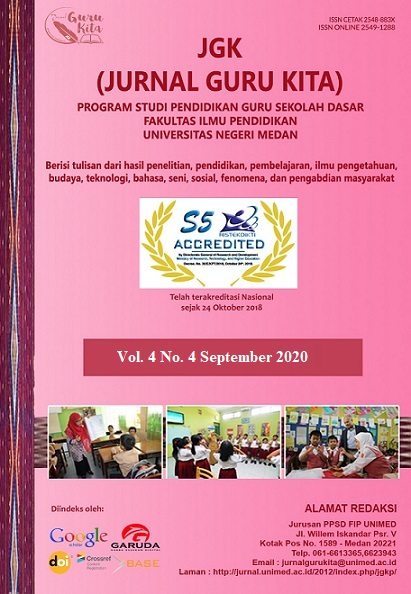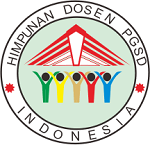PENGEMBANGAN MODUL BERBASIS CONTEXTUAL TEACHING AND LEARNING (CTL) MELALUI METODE EKSPERIMEN PADA POKOK BAHASAN KOLOID
DOI:
https://doi.org/10.24114/jgk.v6i3.35669Keywords:
Modules, Contextual Teaching and Learning, Colloids, Model Dick and CareyAbstract
Abstract: Development of Contextual Teaching and Learning (CTL) Based Modules Through Experimental Methods on Colloidal Subjects. This study aims to (1) determine the level of validation of learning modules on colloidal materials developed based on CTL, (2) determine student responses to CTL-based learning modules through experimental methods on colloidal materials, (3) determine student learning outcomes on CTL-based learning modules. through experimental methods on colloidal materials. This study uses the method (R&D) with the Dick and Carey model at each stage (planning and development, validation, revision (modification), and product testing). The product developed has been validated by 3 expert validators consisting of 2 chemistry lecturers and 1 chemistry teacher. The average result of contextual-based module analysis (CTL) by chemistry lecturers and teachers that has been developed is ± 3.51. This is a very feasible criterion and can be used as teaching material. Based on the assessment of the percentage level of student interest in the module that has been developed, it is 88.67 (very high). Using a CTL-based module on colloidal subjects, student learning outcomes increased to 82.86% with a maximum score of 95 and a minimum of ± 70 and the posttest average of 83 > KKM score of ± 70. Based on hypothesis testing using hypothesis testing, it resulted tcount > ttable that is 11,794 > 1,690.References
Anisa, R. Rayendra, W, B. dan Bambang, S. (2018). Pengembangan Modul Pembelajaran Fisika Berbasis Learning Cycle 5 E Pokok Bahasan Getaran Harmonis Untuk Siswa SMA. Jurnal Pembelajaran Fisika. 7 (2). 181-188.
Herawati, N. S., & Muhtadi, A. (2018). Pengembangan modul elektronik (e-modul) interaktif pada mata pelajaran Kimia kelas XI SMA. Jurnal inovasi teknologi pendidikan, 5(2), 180-191.
Khaeriyah, E., Saripudin, A., & Kartiyawati, R. (2018). Penerapan metode eksperimen dalam pembelajaran sains untuk meningkatkan kemampuan kognitif anak usia dini. AWLADY: Jurnal Pendidikan Anak, 4(2), 102-119.
Muga, W., Suryono, B., & Januarisca, E. L. (2017). Pengembangan bahan ajar elektronik berbasis model Problem Based Learning dengan menggunakan model dick and carey. Journal of education technology, 1(4), 260-264.
Prastowo,A. 2013. Panduan Kreatif Membuat Bahan Ajar Inovatif. Yogyakarta : Diva Press.
Rahayu, S. E., & Febriaty, H. (2017). Penerapan Model Pembelajaran Contextual Teaching And Learning (CTL) Untuk Meningkatkan Pemahaman Materi Pasar Valuta Asing Pada Mata Kuliah Ekonomi Internasional 2 (Studi Mahasiswa Semester 5 Jurusan Ekonomi Pembangunan Fakultas Ekonomi UMSU). Jurnal Ilmiah Manajemen dan Bisnis. 16(2).
Sinambela, P. N. J. M. (2017). Kurikulum 2013 dan Implementasinya Dalam Pembelajaran. Generasi Kampus, 6(2), 17“29.
Subekti, T. Alawiyah, E, M, L. dan Sumarlam. (2016). Pengembangan Modul B. Indo Bermuatan Nilai Karakter Kebangsaan Bagi Mahasiswa PGSD. Profesi Pendidikan Dasar. 3 (2). 92-101
Downloads
Published
How to Cite
Issue
Section
License
Authors published with the JGK (Jurnal Guru Kita) agree to the following terms:
- Authors retain copyright and grant the journal the right of first publication with the work simultaneously licensed under a Creative Commons Attribution License (CC BY-SA 4.0) that allows others to share the work with an acknowledgment of the work's authorship and initial publication in this journal.
- Authors are able to enter into separate, additional contractual arrangements for the non-exclusive distribution of the journal's published version of the work (e.g., post it to an institutional repository or publish it in a book), with an acknowledgment of its initial publication in this journal.
- Authors are permitted and encouraged to post their work online (e.g., in institutional repositories or on their website) prior to and during the submission process, as it can lead to productive exchanges, as well as earlier and greater citation of published work. (See The Effect of Open Access)




























